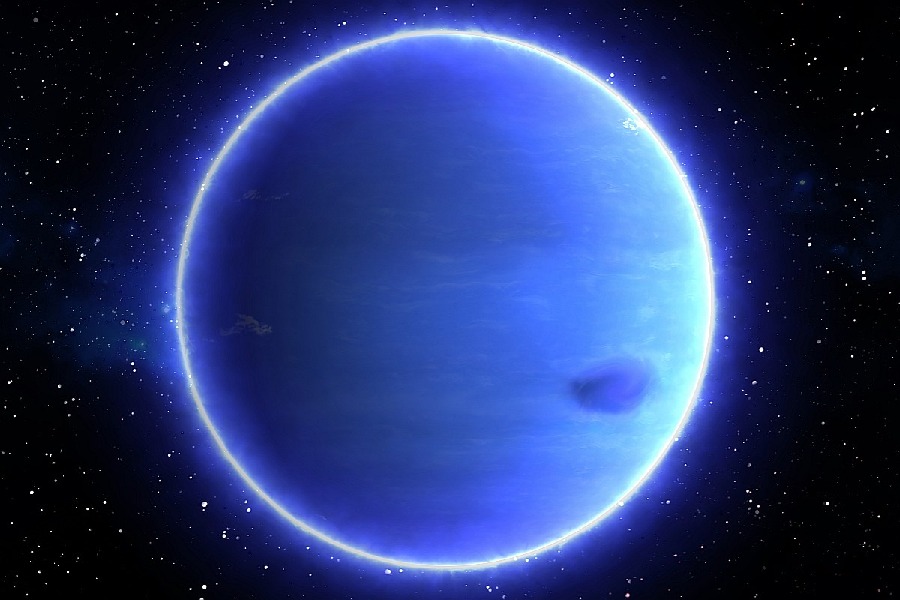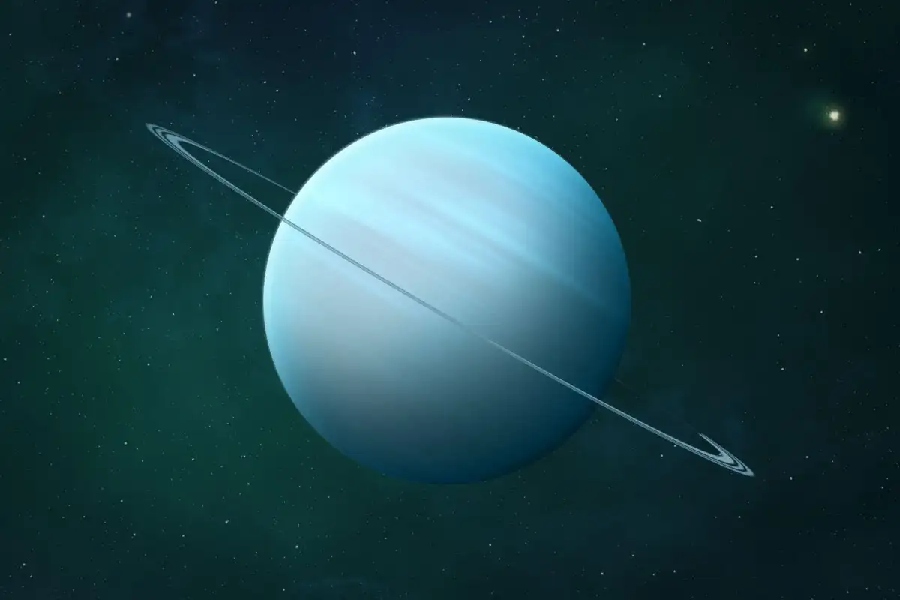As the furthest officially recognized planet from the Sun, icy Neptune has always been a bit of an oddball. Its blue hue, ring system, and a fleet of moons seem oddly matched with the hot, rocky worlds closer in. If it wasn’t for math, we may have never heard of Neptune, and this mesmerizing planet wouldn’t be one of the eight planets in our solar system. So what events could have created this cold giant planet, some 30 times farther out than Earth? How did Neptune form, and what had led to its composition?
With its composition distinct from its neighbors, Neptune clearly had different origins. By analyzing what we know about Neptune’s orbits, rings, moons, and more, scientists have pieced together plausible formation scenarios. We’ll look at the pivotal role played by the early solar system’s layout, conditions, and events that may have enabled Neptune’s birth. The story is still unfinished, but we can slowly pick up the missing pieces.

How Did Neptune Form?
Neptune formed from a vast cloud of gas and dust in space. Gravity caused these particles to come together, clumping and merging over millions of years. As the mass grew, its gravitational pull intensified, attracting more material.
This process continued until Neptune, the eighth planet from the sun, took shape. With a thick atmosphere and an icy core, it’s a distant giant in our solar system, born from the dance of cosmic elements in the early stages of our celestial neighborhood.
Discovery of Neptune in 1846
Historical significance of Neptune’s discovery
Uranus had unexplained orbital irregularities. In 1845, mathematicians John Couch Adams and Urbain Le Verrier calculated Neptune’s possible location. They used Newton’s laws and Uranus’ orbit. This breakthrough showed Newton’s laws could be utilized for discoveries; it set the stage for mathematical calculations in astronomy.
Astronomer Johann Galle used Le Verrier’s figures. On September 23, 1846, he observed Neptune’s position. It was less than 1 degree off from the predictions – this was an amazing mathematical and observational feat.
Galle’s sighting cemented the reality of Neptune’s existence per the math; it built further trust in astronomy’s quantitative methods.
Finding Neptune proved Newton’s laws work well, even far from the Sun, with minimal gravity, it also showed that math can predict even unseen celestial objects.
This event expanded astronomy’s reach into space. The Neptune discovery finished the solar system roster we know today; it enabled future mathematical searches for even more distant worlds.
Role of mathematical predictions and observational evidence
Math guides the way
Math gave the coordinates to locate Neptune; it was the first planet found using laws and formulas, not randomly sighted by telescope like other planets before. Quantitative astronomical methods gained initial prominence via Neptune; this built interest in developing further predictive techniques.
Telescope confirms the discovery
Math alone doesn’t make discoveries. Galle first viewed Neptune via telescope after the calculations. Both evidence types were critical to learning about Neptune. Observational proof remains key to certifying predictions in astronomy; math and telescopes jointly further knowledge.
A scientific achievement
Predicting then seeing Neptune raised astronomy’s status. It exhibited scientific maturity by leveraging math, observation, and reasoning; setting the stage for investigating celestial phenomena.
Neptune’s discovery showed astronomy’s capability as a serious science and enabled the field to move beyond pure observation alone.
Internal Structure of Neptune
Layers that make up Neptune’s internal structure
Neptune likely has a solid inner core. It is made of iron, nickel, and silicate rock. This dense central part spins on a tilted axis. It may account for some of Neptune’s unusual magnetism.
Surrounding the inner core is an outer core. It consists of liquid metal, hydrogen, and compounds. Convection currents here generate Neptune’s magnetic field. The process is similar to Earth’s dynamo region.
An intermediate mantle region probably exists under Neptune’s cores. It has varied ice, rock, and gas layers. Slow convection happens as material circulates amid pressure and heat changes.
Composition of Its core, mantle, and atmosphere
Neptune’s inner core makes up 5-15% of its mass. Pressure compacts the metals and silicates to almost Earth-core density. This region spins offset from other layers due to angular forces.
The outer core comprises over half of Neptune’s total mass. Fluid currents of hydrogen, helium, and iron here generate a potent magnetic cocoon around the planet. It is a protective buffer against solar and cosmic radiation.
Neptune’s wide mantle is 20-25% of its mass. It includes ammonia, methane, and water ice layers between hotter lower and colder upper regions. Gradual convection alters states as material shifts density and temperature.

Outermost Layer of the Planet
Characteristics of Neptune’s outermost layer
Neptune’s outer layer is its atmosphere. It makes up 5-10% of its mass; the atmosphere consists mostly of hydrogen and helium. It also has traces of methane, which give Neptune its blue color.
Neptune’s atmosphere has the fastest winds in the solar system; they can reach up to 1,500 mph. These jet streams are likely related to heat flows from the planet’s hot interior.
Neptune’s atmosphere shows various weather activities, including changing cloud bands and violent storms like the Great Dark Spot. Atmospheric pressure causes methane to act as a liquid, enabling storm formation.
Unique features that distinguish it from other gas giants
Neptune has an unusually tilted magnetic field; it is off by 47 degrees from its spin axis. This extreme skew relative to all other planets may result from interior convection shifts.
Neptune’s atmosphere has a higher proportion of nitrogen than Uranus’ does; this may offer clues into the planets’ different origin stories from the early solar system.
Neptune orbits 30 times farther from the Sun than Earth, meaning it receives much less solar heating than Jupiter and Saturn. But its winds are fiercer than any neighboring gas giant; its atmosphere uniquely evolves in a cold environment.
Polar Regions & White Clouds
Characteristics of Neptune’s polar regions
Neptune’s poles receive less heating than its equator, temperatures plunge down to -224° C or -371.2° F. Polar cold helps methane gas condense to liquid form for storms.
Many storms churn in Neptune’s polar regions. This includes circumpolar drifting cloud features. Polar cold promotes atmospheric pressure and density shifts to fuel storms.
A strange vortex storm hovers over Neptune’s south pole, resembling hurricanes on Earth. Wind shear alters the usual oval shape into a more irregular formation over time.
Presence and significance of white clouds in its atmosphere
White clouds dot Neptune’s upper atmosphere. They likely form from condensed methane snow crystals. Gravity pulls them down to even lower deck layers over time.
Those upper clouds significantly impact how Neptune appears in telescopes. As they move and dissipate, they create brighter or darker blue hues.
How clouds form and evolve aids in studying distant exoplanet atmospheres, too. Neptune offers a prime model for this atmospheric science crucial to exploring gas giants.
Movement & Rotation of Neptune
Neptune’s movement in its orbit around the sun
Neptune orbits the Sun once every 165 years; its orbit is over 5 billion km. Neptune’s orbit is more oval-shaped than circular compared to other planets. Neptune moves an average of 30,000 mph in orbit. But gravitational tugs from Uranus and other bodies periodically alter its exact speed slightly over decades.
Neptune’s equator and orbit tilt differently – by 28 and 29 degrees. This mismatch shows rotation and revolution axes independence.
Distinctive patterns in its rotation
Neptune spins quickly – a 16-hour day. This rapid rotation squishes it at the poles and bulges its equator outward – an oblate shape. Neptune has two alternating wind and storm patterns in each hemisphere. Every few decades, these systems reverse direction – the cause is unknown.
Neptune’s magnetic poles are oddly shifted or tilted compared to its spin orientation. This distinct lack of symmetry is unique among planets thus far.
Orbital period & differential rotation
One Neptune year is equivalent to about 165 Earth years. This is due to its vast distance from the Sun at 30 AU. This sets Neptune’s slow orbital pace. Long orbits mean less frequent solar heat absorption. Less radiation leads to planet cooling. This impacts atmospheric characteristics for Neptune.
Despite a slow orbit, Neptune’s spin is quite fast. A 16-hour day shows its rotational velocity is largely decoupled from distant orbital speed.
Variations in Neptune’s rotational patterns
When the equator spins more quickly, Neptune exhibits differential rotation, where its equator spins faster than its poles. Equatorial speed tops 1000 mph – poles move slower at 750 mph. At times, Neptune’s atmospheric winds and storms reverse direction. Every few decades, winds switch from eastward to westward and back.
Neptune’s internal dynamo generates a magnetic field not aligned to its spin axis. Instead, the field axis tilts almost 50 degrees off where expected. This asymmetry is distinct among planets.
Size and Distance of Neptune
The physical size of Neptune
Neptune’s equatorial diameter is 49,500 km wide. This makes it approximately four times wider than planet Earth’s 12,700 km diameter. Given Neptune’s large size, its total volume is 57 times more than Earth’s. And at 17 times Earth’s mass, it is quite dense and heavy for a gas giant.
From Earth, Neptune appears 2 to 2.4 arcseconds wide, depending on where it orbits relative to us. This tiny visible size makes details very hard to discern.
Distance from the sun and placement in the solar system
Neptune orbits about 30 astronomical units (AU) from the Sun. At 4.5 billion miles away, sunlight takes 4 hours for light to reach Neptune. Neptune lies just beyond a region called the Kuiper Belt, filled with icy asteroids and dwarf planets.
This frozen zone may have fueled Neptune’s formation. Neptune’s wide elliptical orbit means Pluto’s smaller orbit crosses it at times as their paths intersect. The two objects gravitationally tussle during these close encounters.
Conclusion
We come to the end of our exploration into how Neptune formed. As the most distant official planet from the Sun, Neptune has always posed a mystery. How did Neptune form? How did this cold, dark, and dynamically complex world come to be?
We have covered theories ranging from core accretion to gravitational tugs from the outer solar system pulling Neptune into place – piecing together clues from Neptune’s composition, location, moons, and more. Scientists have devised plausible formation scenarios for this little-understood giant.
There are still open questions, but it’s clear Neptune’s beginnings were intrinsically tied to the layout and events in the early solar nebula.
